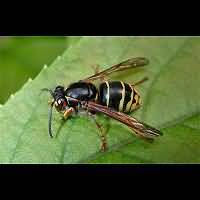[All pictures of garden wildlife on this page are thumbnails. Click on any thumbnail for a large format to be displayed.]

Median Wasp (Dolichovespula media)
| Taxonomy | ||||||
|---|---|---|---|---|---|---|
| Kingdom: | Phylum: | Class: | Order: | Family: | Genus: | Species: |
| Animalia | Arthropoda | Insecta | Hymenoptera | Vespidae | Dolichovespula | D. media |
The Median Wasp is black with yellow stripes. The stripes on the thorax may be reddish though. This species is highly variable, especially the intensity of the yellow colour differs from specimen to specimen. When there is quite a lot of red on the thorax, the Median Wasp resembles the Hornet. It is however smaller and more slender. Often the Median Wasp is one of the very few paper wasps identifiable in the field, for it often looks like a very dark wasp. The first few stripes on the abdomen may be extremely small or even absent. Some animals appear to be black completely. Blackish animals, reddish one, all variations occur within one nest. The markings on the clypeus are distinctive as well: at about one third from the top there is a black circle or oval, often with a tiny band running to the top of the clypeus. Finally the Median Wasp has a sign of "7" on the sides of the thorax. Apart from the much bigger Hornet the Median Wasp is our biggest Paper Wasp. Queens may grow to a length of 18 to 22mm. The workers and the drones reach a bodily length of 15 to 19mm.
The queen starts building the nest by the end of April. Usually the nest is hanging attached to a branch of a tree or in shrubs but sometimes also on buitdings attached to gutters or roof constructions. The nest has the shape of a football at first, but becomes oval later. Fresh nests have a very long downwards pointing tunnel which serves as an entrance. This tunnel maybe 4 times as long as the nest itself. When there are enough workers the tunnel is liquidated. Older nests have the opening at the side, usually about one third from the bottom and no tunnel is to be seen. The nest of the Median Wasp has so-called air chambres. These are small attachements on the outside to the nest, which ensure circulation of air within the nest. The funny thing with the Median Wasp is that these chambres are present, but they are entirely closed. This is an important characteristic of the nests of this species. The paper of which the nest is being made is very smooth and bright grey, often with a blueish appearance. Some layers can be yellowish, though. The nest has a maximum of six combs and some 900 to 1,700 inhabitants, including eggs and larvae. At its height a nest contains about 500 workers. The first workers appear by the end of may or the beginning of June. As the species is quite big and the nest is made in places where it is for everyone to see, many nests are destroyed. Yet the Median Wasp is a peaceful species. It will fly away from you rather than attack you. Still quite some people are stung by this species, mainly because some nests, especially those in shrubs, are hard to see and gardeners may disturb them during pruning. This species is attracted to sweet food and may come to you at a terrace. By waving at it, you will scare it off which is contrary to the Common and German Wasp, which only get agitated when being waved at. Curiously enough Cuckoo Wasp is of no threat to Median Wasp but a parasitic wasp called Sphecophaga vesparum is. Sphecophaga vesparum deposits her eggs on a larva of the Median Wasp which has just hatched. After hatching herself, the larva of the parasitic wasp will eat the larva of the Median wasp.
Common species over much of Europe. It doesn't like warm conditions though. In Southern Europe for instance it is only seen in mountain areas. A new species to Britain, which appeared in the mid-1980's. It rapidly spreads its wings in Britain and is now found in most of southern England.

© Copyright 1998-2024 gardensafari.net (Hania Berdys)

 English / engels
English / engels  Dutch / nederlands
Dutch / nederlands
